Bulletin – September 2018 Finance Interest Rate Benchmarks for the Australian Dollar
- Download 485KB

Abstract
Interest rate benchmarks are widely relied upon in global financial markets. They are referenced in contracts for derivatives, loans and securities. They are also used by market participants to value financial instruments, and by investment funds as benchmarks for assessing their performance. The key interest rate benchmarks for the Australian dollar are the bank bill swap rates (BBSW) and the cash rate. This article provides an overview of these benchmarks, and the reforms that have been undertaken over recent years to make them more robust.
The Origins and Use of Credit-based Benchmarks
Credit-based interest rate benchmarks are typically designed to measure the rate at which banks can borrow funds in wholesale money markets. The most widely used credit-based benchmarks in the world are the London Interbank Offered Rates (LIBOR). These benchmarks measure the rates at which banks can borrow funds in the interbank market for terms from overnight to one year in US dollars, British pounds, euros, Japanese yen and Swiss francs.[1] The LIBOR benchmarks were originally developed in the 1960s for use in syndicated loans, so that the interest rate paid on the loan would move over time in line with the funding costs of the banks in the loan syndicate. Currently, financial contracts that reference LIBOR are estimated to have a total notional value of around US$350 trillion; these contracts are primarily derivatives, such as interest rate swaps.
The equivalent credit-based benchmarks for the Australian dollar are the bank bill swap rates (BBSW). These benchmarks measure the cost for highly rated banks in Australia to issue short-term bank paper for each monthly tenor between one month and six months. BBSW emerged in the mid 1980s as the key benchmarks for use in the Australian interest rate swap market.[2] BBSW was administered by the Australian Financial Markets Association (AFMA) until this responsibility was transferred to the Australian Securities Exchange (ASX) in 2017.
BBSW is estimated to be referenced in contracts with a notional value of around A$18 trillion, including derivatives, loans and securities (Table 1). Derivatives referencing BBSW are widely used by market participants to hedge their interest rate risk. BBSW is used as a reference rate in around one-third of non-government bonds denominated in Australian dollars, in almost all asset-backed securities issued by Australian securitisation trusts, and in some issuance by state and territory governments. BBSW is also referenced in syndicated loans and corporate loan contracts. Since BBSW is so widely used by banks, movements in BBSW affect funding costs, which can influence lending rates on loans to households and businesses. In addition, BBSW is used by some market participants as the discount rate for valuing a range of other debt securities and derivatives.[3] It is also an input to the calculation of performance indices for investment funds, such as the Bloomberg AusBond Bank Bill Index.[4]
| BBSW is referenced in: | Amount outstanding |
|---|---|
| Derivatives | $17 trillion* |
| Business loans | $300 billion |
| Debt securities | |
| – Non-government securities | $200 billion |
| – Asset-backed securities | $440 billion |
| – Semi government securities | $20 billion |
| The cash rate is referenced in: | |
| Derivatives | $7 trillion* |
|
* The amount outstanding for derivatives are notional values; these are the total amounts on which the interest payments to be exchanged in the derivatives contracts are based. Sources: ASIC; RBA |
|
International Reform to Address Issues with Benchmarks
Following the global financial crisis, several financial benchmarks were found to have been subject to manipulation attempts by market participants. These problems were most prominent for LIBOR, which is calculated based on submissions from a panel of banks. For BBSW, there were also issues identified regarding trading in the bank bill market around the time of day that the benchmark was being calculated. Over recent years, several banks have entered into enforceable undertakings with the Australian Securities and Investments Commission (ASIC) in relation to their conduct around the setting of BBSW.
In response to the weaknesses identified in the setting of financial benchmarks, the global regulatory community launched a reform program to strengthen financial benchmarks. The key organisations coordinating this work have been the International Organization of Securities Commissions (IOSCO) and the Financial Stability Board (FSB). IOSCO published the Principles for Financial Benchmarks in 2013, with the aim of improving the robustness and integrity of benchmarks. The IOSCO Principles were endorsed by the FSB as the global standard. These Principles set out best-practice governance arrangements for benchmark administrators. They also stress that benchmarks should be anchored to an active market and derived from transactional data where possible.
To oversee the work on interest rate benchmark reform, the FSB established an Official Sector Steering Group (OSSG), of which the Reserve Bank has been a member. The OSSG has been involved in three work streams that:
- strengthen the interbank offered rates (IBORs, which include LIBOR and BBSW) by anchoring them to a greater number of transactions, and improve processes and controls around submissions
- identify alternative risk-free rates (RFRs) that are IOSCO compliant, and encourage derivatives to be referenced to them instead of IBORs
- ensure contracts referencing IBORs include robust fall-back provisions, to reduce risk of financial instability if the IBOR was to be discontinued.
After considerable effort to strengthen the LIBOR benchmarks, the UK Financial Conduct Authority has come to the conclusion that these benchmarks are unlikely to remain viable. Activity in the interbank markets upon which these benchmarks are based has declined noticeably since the financial crisis. As a result, the banks making LIBOR submissions typically need to use their expert judgment. These banks are reluctant to continue doing this, and have only committed to supporting LIBOR until the end of 2021, so users of LIBOR need to plan for the eventual cessation of these benchmarks.
The LIBOR benchmarks are the only credit-based benchmarks for the US dollar, British pound and Swiss franc, so it will be essential for users that reference LIBOR for these currencies to transition to alternatives. The regulators in these jurisdictions have worked with market participants to identify and publish RFRs that are underpinned by active markets (Table 2). The Federal Reserve has started publishing the new RFR for the US dollar, the Secured Overnight Financing Rate (SOFR), which is a broad measure of the rate on overnight repurchase agreements (repos) collateralised by US Treasury securities. Similarly, the Bank of England has strengthened the methodology for the RFR for the British pound, the Sterling Overnight Index Average (SONIA). Users of LIBOR are now being encouraged to transition away from LIBOR towards these RFRs.
| Currency | Credit-based benchmarks (IBORs) | Alternative risk-free rate (RFR) | Approach being taken |
|---|---|---|---|
| US dollar | London Interbank Offered Rate (LIBOR) | Secured Overnight Financing Rate (SOFR) | Transition from LIBOR to SOFR |
| British pound | LIBOR | Sterling Overnight Index Average (SONIA) | Transition from LIBOR to SONIA |
| Swiss franc | LIBOR | Swiss Average Rate Overnight (SARON) | Transition from LIBOR to SARON |
| Japanese yen | Tokyo Interbank Offered Rate (TIBOR) and LIBOR | Tokyo Overnight Average Rate (TONAR) | Multiple-rate approach with both TIBOR and TONAR |
| Canadian dollar | Canadian Dollar Offered Rate (CDOR) | Canadian Overnight Repo Rate Average (CORRA) | Multiple-rate approach with both CDOR and CORRA |
| Australian dollar | BBSW | Cash Rate | Multiple-rate approach with both BBSW and Cash Rate |
|
Sources: ISDA; RBA |
|||
Some other currencies, such as the Japanese yen, Canadian dollar and Australian dollar, have existing credit-based benchmarks that are independent of LIBOR. The regulators in these jurisdictions have come to the conclusion that these credit-based benchmarks can be maintained alongside an alternative RFR; this has become known as the ‘multiple-rate approach’. For instance, for the Japanese yen, a new methodology has been put in place for the Tokyo Interbank Offered Rate (TIBOR), which draws on a broader range of transactions in wholesale funding markets. Similarly, the Australian regulators have supported reforms to the methodology for BBSW so that they can remain robust credit-based benchmarks, which can coexist alongside the RFR for the Australian dollar, which is the cash rate.
Strengthening the BBSW Methodology
The Australian financial regulators have been working closely with the ASX and market participants to ensure that BBSW remains robust. Unlike LIBOR, there are enough transactions in the Australian bank bill market to allow the calculation of robust benchmarks. BBSW is underpinned by a longstanding market in bank bills and negotiable certificates of deposits issued by highly rated ‘prime banks’ (we will refer to these instruments through the remainder of the article as ‘bank paper’). In this market, banks issue paper as a regular source of funding, and a wide range of wholesale investors purchase bank paper as a liquid cash management product. Over recent years, the outstanding stock of prime bank paper has ranged between $120 billion and $150 billion, and the total market in Australian dollar bank paper has been around $200 billion (Graph 1).
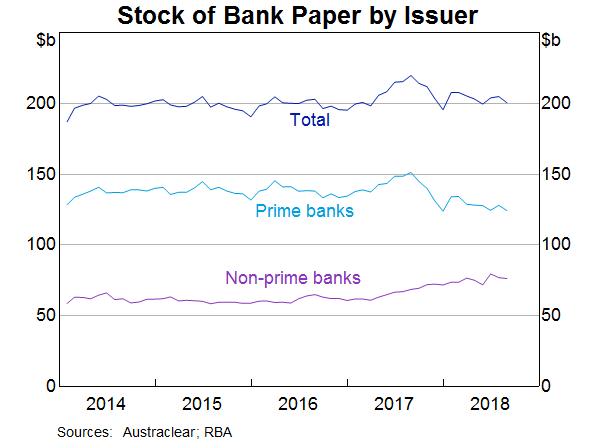
BBSW was originally calculated by surveying a panel of banks, where each panellist was asked to submit an assessment of where prime bank paper was priced at 10 am, Sydney time. Following the controversy surrounding LIBOR, banks became less willing to participate in the survey, with four banks withdrawing from AFMA's BBSW survey in early 2013. To address these issues, from September 2013, AFMA replaced the submissions-based methodology with the National Best Bid and Offer (NBBO) methodology, which used executable bids and offers for prime bank paper in the interbank market to calculate BBSW.[5] The bids and offers were sourced from approved interbank trading venues at three points in time around 10 am (i.e. 9.59, 10.00 and 10.01 am). Initially, the new methodology was successful, with liquidity increasing in the interbank market (RBA 2013). However, by 2015, market participants had become reluctant to trade around the time of the rate set.
In response to concerns about the low volume of trading around the time of the rate set, the Council of Financial Regulators (CFR) launched a consultation in October 2015 on how the BBSW methodology should evolve (Debelle 2016). During this consultation, market participants highlighted several reasons for the lack of trading during the rate set:
- They faced a potential conflict of interest when they participated in the market underpinning the benchmark and the derivatives market that references it. They stated that they were uncertain about how regulators expected them to manage these conflicts. To address this, the Australian Government has recently introduced a new regulatory framework for financial benchmarks, which is outlined later in this article.
- Managers of investment funds were reluctant to trade at outright yields. They preferred to transact at the yet-to-be-determined rate at which BBSW would be published, since this minimised tracking error against their performance benchmarks.
- Following the introduction of liquidity regulations requiring banks to hold high-quality liquid assets (HQLA), foreign banks had less incentive to purchase bank bills as a liquid instrument since they were not considered as HQLA by their home prudential regulators.
There has also been a significant change in the sectoral composition of the holders of bank paper. While banks were the dominant purchasers of this paper 10 years ago, investment funds have become the predominant purchasers over recent years (Graph 2).
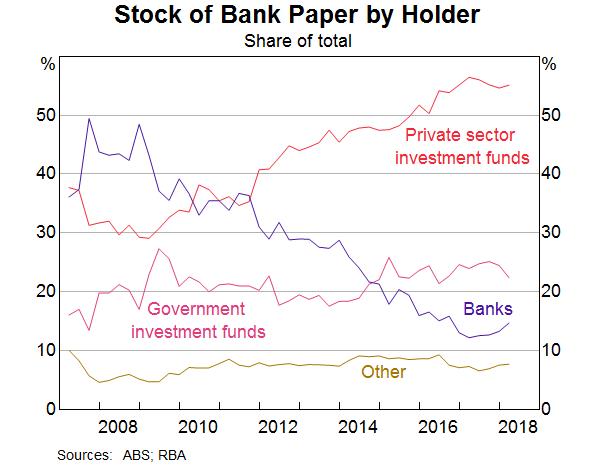
To address the low trading volumes during the rate set window, in February 2016, the CFR recommended that the BBSW methodology be strengthened to enable the benchmark to be calculated directly from a wider set of market transactions. Over the following two years, AFMA and the ASX, with the support of the financial regulators, have taken the necessary steps to implement this recommendation (Table A1). Given the larger role that non-bank investors play in the market, the definition of the underlying market has been broadened beyond interbank trading to include a wider range of counterparties such as private sector and government investment funds. The rate set window has also been lengthened to capture transactions from 8.30 am to 10 am.
The ASX now calculates BBSW directly as the volume-weighted average price (VWAP) of all eligible primary and secondary market transactions in prime bank paper during the rate set window.[6] The VWAP method is at the top of a robust calculation waterfall for BBSW, so the benchmark can continue to be published as conditions change in the bank bill market. The VWAP method is used when there are sufficient underlying transactions from a diverse range of market participants.[7] In situations where VWAP cannot be formed, the NBBO calculation method is used to determine BBSW for that tenor. Then if BBSW cannot be formed under the NBBO method, an algorithmic fall-back calculation would be used.[8]
For it to be possible to calculate BBSW directly from transactions, the way market participants traded prime bank paper needed to change. To build confidence in trading during the rate set window at outright yields (rather than at the rate where BBSW was published for the day), the ASX worked closely with market participants to develop a new set of trading guidelines for BBSW; these were published in October 2017 (ASX 2018c). These provide guidance on the trading of bank bills during the rate set window and helped address the concerns that some participants had about trading during the rate set. From December 2017, to prepare for the transition to the VWAP methodology, market participants started trading bank bills at outright yields during the rate set window.[9] This change in market practice was smoothly implemented, enabling these transactions to be used to calculate BBSW.
In addition, it was necessary to put new technical infrastructure in place to ensure that trades in prime bank paper would be reported to the ASX in a timely manner so that BBSW could be published by 10.30 am each day. The new arrangements also improved market functioning by encouraging more electronic trading and straight-through processing of transactions. Since March 2018, market participants have been required to submit trade reports via an approved trading venue. An industry-wide testing phase was conducted for two months before the formal adoption of the new methodology. Comparisons during this parallel run showed that the difference between the rate calculated using VWAP and the existing NBBO method was very close to zero. Given this, there was a seamless transition to the new BBSW methodology when it became operational in May 2018.
The Performance of the New BBSW Methodology
By widening the rate set window and capturing transactions outside the interbank market, the volume of transactions underpinning BBSW has increased substantially under the new methodology; since May 2018, there has been an average of around $1.8 billion in transactions during the rate set each day across all tenors, compared to around $100 million previously. It is estimated that around 80–90 per cent of trading in the market for prime bank paper is occurring during the rate set window. As a share of prime bank paper outstanding, turnover during the rate set is over 10 times higher under the new methodology (Graph 3). The increase in trading during the rate set has not only occurred for the most traded tenors of 1-, 3- and 6-month BBSW, but also for the other tenors, which were rarely traded previously (Graphs 4 and 5).
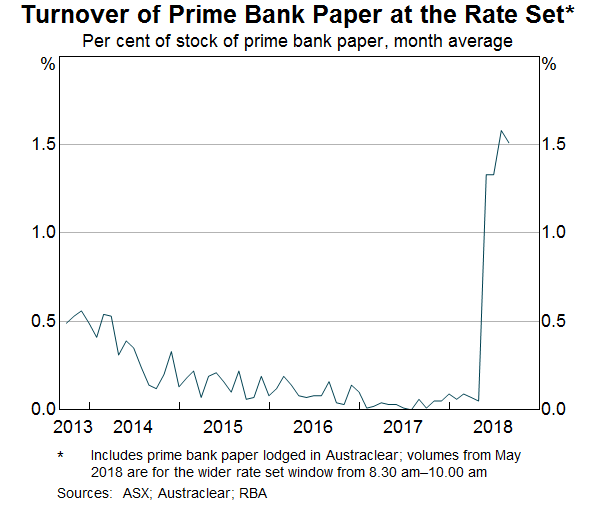
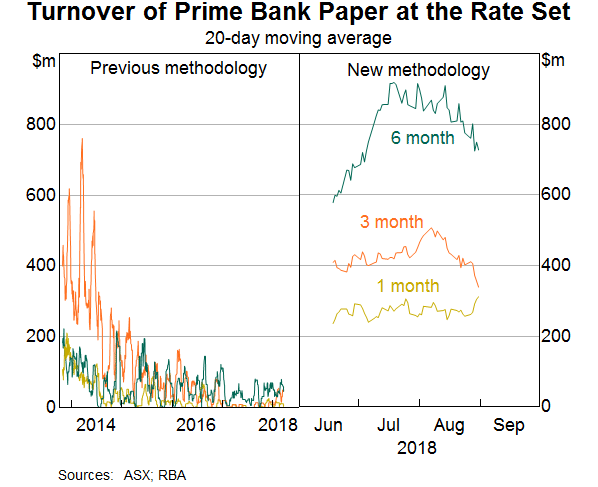
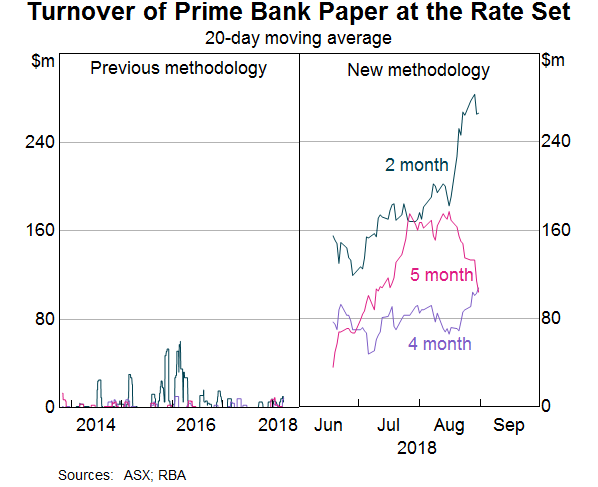
The new methodology has confirmed that the most robust tenors are 6- and 3-month BBSW, which are most frequently referenced in derivatives. Turnover of prime bank paper underlying 6-month BBSW, in particular, is noticeably above turnover in the 1-month tenor. This reflects that banks have increased the tenor of their wholesale funding, since otherwise they would be required under the liquidity standards to hold additional HQLA. While VWAP can be formed on almost all days for 6-month BBSW and most days for 3-month BBSW, VWAP for 1-month BBSW is only formed about half the time (Graph 6). Nevertheless, there are still many contracts that reference 1-month BBSW. Users of products referencing 1-month BBSW should consider referencing 6- or 3-month BBSW in future (Debelle 2018).
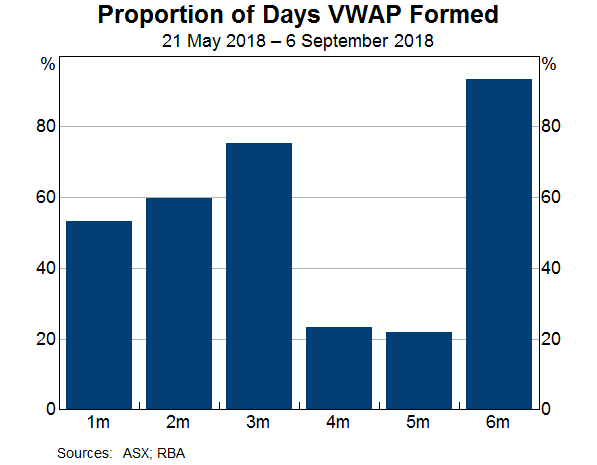
There is a wide range of participants in the market for prime bank paper during the rate set window, with around 80 different institutions participating over recent months. These include the prime banks that are mainly selling their paper, and a range of investors that mainly purchase paper, including money market funds, superannuation funds, insurance companies, other banks and state treasury corporations. Purchases by investors are concentrated in the most liquid 6- and 3-month tenors; these investors often sell paper back to the banks around the 1-month tenor (Table 3). The vast majority of investors who purchase prime bank paper during the rate set window are domiciled in Australia, but there are also some investors from other countries such as the United States, Japan, Singapore, New Zealand and the United Kingdom. Trading in bank bills is typically well spread across the rate set window from 8.30 am to 10 am, with relatively little trading occurring after the window (Graph 7).
| 1m | 2m | 3m | 4m | 5m | 6m | |
|---|---|---|---|---|---|---|
| Prime bank paper sold by: | ||||||
| – Prime banks | 35 | 54 | 89 | 72 | 31 | 100 |
| – Investors | 65 | 46 | 11 | 28 | 69 | 0 |
| Prime bank paper purchased by: | ||||||
| – Prime banks | 68 | 47 | 16 | 32 | 74 | 5 |
| – Investors | 32 | 53 | 84 | 68 | 26 | 95 |
|
Sources: ASX; RBA |
||||||
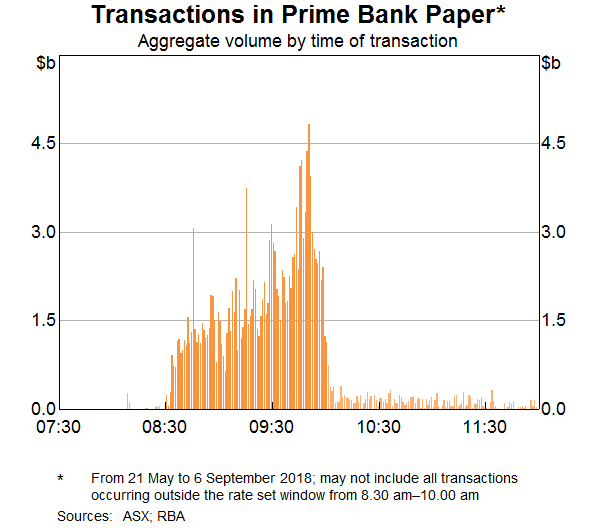
New Benchmarks Regulatory Framework
The Australian Government has introduced a new regulatory framework for financial benchmarks. This has helped to reduce the uncertainty faced by market participants when participating in the BBSW rate setting process while also referencing BBSW in their contracts. There are three key components to the framework. First, the legislation empowers ASIC to identify and declare significant financial benchmarks, such as BBSW, and establishes a new licensing regime for administrators of those benchmarks. Second, ASIC has the power to compel submissions to a significant benchmark in the rare circumstances where the benchmark would otherwise cease to be published. Third, the legislation has made it an offence to manipulate financial benchmarks. The new Australian regulatory framework should also support the continued use of BBSW in the European Union, which has put in place new benchmark regulations. These regulations apply to benchmarks used in the European Union, including BBSW, and require these benchmarks to be subject to appropriate regulation.
The Cash Rate as the Risk-free Benchmark for the Australian Dollar
As noted above, RFRs are the main alternatives to credit-based benchmarks, particularly for currencies where credit-based benchmarks have become unsustainable. RFRs are typically based on overnight funding markets since there are sufficient transactions in these markets to calculate robust benchmarks. For some currencies, the RFR is based on an unsecured lending market, such as SONIA for the British pound, while in others the RFR is based on the repo market, such as SOFR for the US dollar.
The RFR for the Australian dollar is the cash rate. The cash rate is best known as the Reserve Bank Board's operational target for monetary policy. The cash rate influences other interest rates and forms the base on which the structure of interest rates in the economy is built. Movements in the cash rate are quickly passed through to other capital market interest rates such as money market rates and bond yields, and then feed through to banks' deposit and lending rates.
The cash rate is also a significant financial benchmark in the Australian financial markets. The cash rate is the reference rate for around $7 trillion (notional value) in derivatives, including Australian dollar overnight indexed swaps (OIS) and the ASX 30-day interbank cash rate futures. OIS are a form of fixed-to-floating swap in which one party agrees to pay the other party a fixed rate in exchange for receiving the average cash rate recorded over the term of the swap (RBA 2002). The market for OIS was established in 1999 and has good liquidity for tenors shorter than one year. The cash rate is also an input to the calculation of performance indices used by investment funds, such as the Bloomberg AusBond Bank Bill Index.
The cash rate is administered by the Reserve Bank and calculated as the weighted average interest rate on unsecured overnight loans between banks. In the cash market, banks borrow and lend the balances they hold in their Exchange Settlement Accounts at the Reserve Bank, which are used to settle obligations between banks. The cash market has been functioning since 1959, and the Reserve Bank has been publishing the cash rate ever since (RBA 1991; Cashion 1977).
To strengthen the cash rate benchmark and ensure that the methodology was aligned with the IOSCO Principles, the Reserve Bank implemented a new methodology in May 2016 (Hing, Kelly and Olivan 2016). Before then, the Reserve Bank calculated the cash rate based on a daily survey of banks' aggregate transactions and the weighted average interest rate at which they transacted. Under the new methodology, the cash rate has been calculated directly using the actual transactions in the cash market. Daily cash market turnover has recently averaged around $5 billion, with around 35 transactions taking place each day (Graph 8).
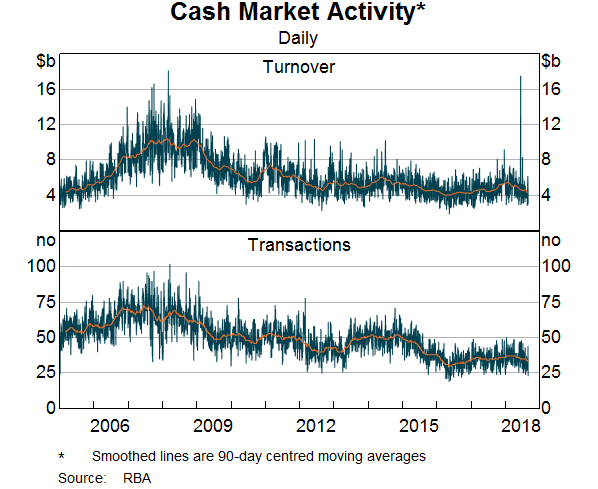
BBSW and the Cash Rate Can Continue to Coexist as Interest Rate Benchmarks
BBSW can continue to exist even if credit-based benchmarks such as LIBOR are discontinued in other jurisdictions. Nevertheless, it is important for market participants to consider whether BBSW is the most appropriate benchmark for their contracts. For many financial products, referencing a credit-based benchmark will still be appropriate. This is particularly the case for products issued by banks, such as floating rate notes (FRNs) and corporate loans. The counterparties to these products would also still need derivatives that reference BBSW so that they can fully hedge their interest rate exposures. For other financial products, an RFR may be more appropriate. For example, FRNs issued by governments, non-financial corporations and securitisation trusts, which are currently priced at a spread to BBSW, could instead link their coupon payments to the cash rate. In addition, as market participants transition from referencing LIBOR to RFRs, there may be some corresponding migration away from BBSW towards the cash rate, particularly for products that reference interest rate benchmarks in multiple currencies, such as cross-currency swaps and syndicated loans.
The infrastructure is in place for BBSW and the cash rate to coexist as the key interest rate benchmarks for the Australian dollar. There is already a functioning derivatives market that allows users to exchange cash flows linked to these benchmarks. The relevant instrument is known as a cash rate/BBSW basis swap, which is an interest rate swap in which one leg of the swap is tied to the cash rate and the other to BBSW. Reflecting market demand for such swaps, these products are now centrally cleared by the major clearing houses.
Conclusion
Interest rate benchmarks play an important role in the smooth functioning of financial markets. Reforms have been undertaken to enhance the robustness of the key interest rate benchmarks for the Australian dollar. In contrast to LIBOR, it has been possible to directly measure BBSW using transactions in the underlying market for bank paper. The most robust tenors are 6- and 3-month BBSW, and users of 1-month BBSW should consider referencing one of these more robust tenors in future. The cash rate is the RFR for the Australian dollar, and is already widely used as a financial benchmark. In future, users should consider whether BBSW or the cash rate is the most appropriate benchmark for their financial contracts.
Appendix
| September 2013 | AFMA changed BBSW methodology from submissions-based to using executable quotes (NBBO) |
| February 2016 | Transactions-based methodology for BBSW recommended by the CFR |
| May 2016 | Reserve Bank implemented reforms to cash rate to ensure compliance with IOSCO Principles |
| August 2016 | AFMA put in place calculation waterfall for BBSW, with algorithmic fall-backs to NBBO |
| October 2016 | Australian Government accepted recommendation from the CFR for the introduction of a new regulatory regime for financial benchmarks |
| January 2017 | ASX replaced AFMA as the administrator of BBSW |
| July 2017 | ASIC published proposed rules for the administration of licensed benchmarks and guidance on how ASIC would administer the proposed benchmark regulatory regime |
| September 2017 | The Australian Government introduced financial benchmarks legislation to the Australian Parliament |
| October 2017 | ASX published BBSW Trade and Trade Reporting Guidelines |
| November 2017 | Time of the Reserve Bank's daily Open Market Operations was brought forward to support the new BBSW methodology |
| December 2017 | Changes to trading practices in market for prime bank paper implemented, including trading bank paper at outright yields |
| March 2018 | Trade reporting for prime bank paper commenced; ASX calculated VWAP in parallel with the existing BBSW methodology |
| April 2018 | The new financial benchmarks regulatory framework came into effect |
| May 2018 | Implementation of the new BBSW VWAP methodology |
| June 2018 | ASIC finalised benchmark rules and declared BBSW and the cash rate to be significant financial benchmarks |
|
Sources: ASIC; ASX; RBA |
|
Footnotes
The authors are from Domestic Markets Department [*]
There was also an Australian dollar LIBOR until the British Bankers' Association discontinued its publication at the end of May 2013 (ATO 2014). [1]
There were some benchmark rates that preceded BBSW, including the Australian Merchant Bankers Association (AMBA) Bill Rate, which was published from 1976 until 1992. BBSW was also preceded by the introduction of the bank bill futures market by the Sydney Futures Exchange in 1979. [2]
Floating-rate debt securities offer variable interest payments linked to a reference rate such as BBSW. Expected future cash flows from floating rate instruments are discounted to arrive at their current value using an interest rate that incorporates an appropriate risk premium, such as BBSW. The valuation of derivatives such as interest rate swaps also involves the discounting of future cash flows. [3]
Performance indices also exist for other Australian dollar asset classes such as the Bloomberg AusBond Composite Index for fixed interest securities issued in the Australian debt market. [4]
Prime banks agree to quote live, executable bids and offers throughout the rate set window as a condition of accepting prime bank status (ASX 2018). [5]
For a transaction to be eligible, it must satisfy a set of criteria: the trade size must meet the minimum notional amount ($10 million or more); occur during the rate set window (8.30 am–10 am AEST/AEDT); the maturity of the security must fall within the rolling maturity pool of +/− 5 business days either side of the straight run maturity date; executed on or reported to an approved trading venue by the end of the reporting window; and have at least one counterparty located in Australia; see ASX (2018b). [6]
Minimum criteria for the volume of transactions and the number of counterparties are: there must be at least four counterparties and three transactions for VWAP to be formed; for each of the 1-, 3- and 6-month tenors, there must also be an aggregate volume of at least $200 million; and for the 2-, 4- and 5-month tenors, at least $100 million; see ASX (2018b). [7]
The algorithmic fall-back calculation is (in descending order): the movement in neighbouring BBSW tenors; the movement in the 90-day bank bill futures contract; and the prior business day's BBSW; see ASX (2018b). [8]
The sampling times for the NBBO was brought forward to 9.44, 9.45 and 9.46 am (from 9.59, 10.00 and 10.01 am) to be within the rate set window from 8.30 am–10 am. The time of the Reserve Bank's Open Market Operations (OMO) was also brought forward in November 2017 from 9.30 am to 9.20 am. This provides market participants the opportunity to trade bank bills during the rate set window taking into account their repo allocation in the OMO dealing round (Debelle 2017). [9]
References
ASIC (Australian Securities and Investments Commission) (2018), ‘Explanatory Statement for ASIC Corporations (Significant Financial Benchmarks) Instrument 2018/420’.
ASX (Australian Securities Exchange) (2018a), ‘ASX Prime Bank Conventions’.
ASX (2018b), ‘ASX Bank Bill Swap (BBSW) Conventions’.
ASX (2018c), ‘ASX BBSW Trade and Trade Reporting Guidelines’.
ATO (Australian Taxation Office) (2014), ‘Administrative Solution: Proxy for the Australian Dollar London Interbank Offered Rate (AUD LIBOR)’.
Cashion, M (1977), ‘The Short Term Money Market in Australia and Its Regulation’, UNSW Law Journal, 2(1), pp. 90–104.
Debelle G (2016), ‘Interest Rate Benchmarks’, Speech at KangaNews Debt Capital Markets Summit 2016, 22 February.
Debelle G (2017), ‘Interest Rate Benchmarks’, Speech at FINSIA Signature Event: The Regulators, Sydney, 8 September.
Debelle G (2018), ‘Interest Rate Benchmark Reform’, Keynote Address at ISDA (International Swaps and Derivatives Association) Forum (appearance via video link), Hong Kong, 15 May.
Hing A, G Kelly and D Olivan (2016), ‘The Cash Market’, RBA Bulletin, December.
RBA (Reserve Bank of Australia) (1991), ‘Authorised Short Term Money Market Dealers’, RBA Bulletin, June.
RBA (2002), ‘Overnight Indexed Swap Rates’, RBA Bulletin, June.
RBA (2013), ‘Box D: Bank Bill Swap Benchmark Rates’, Statement on Monetary Policy, November, pp 55–56.